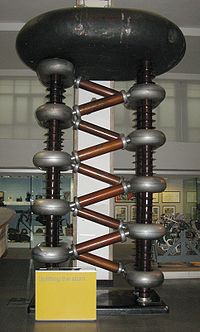- Cockcroft–Walton generator
-
 This Cockcroft–Walton voltage multiplier was part of one of the early particle accelerators responsible for development of the atomic bomb. Built in 1937 by Philips of Eindhoven it is now in the National Science Museum in London, England.
This Cockcroft–Walton voltage multiplier was part of one of the early particle accelerators responsible for development of the atomic bomb. Built in 1937 by Philips of Eindhoven it is now in the National Science Museum in London, England.
The Cockcroft–Walton (CW) generator, or multiplier, is an electric circuit which generates a high DC voltage from a low voltage AC or pulsing DC input. It was named after the British and Irish physicists John Douglas Cockcroft and Ernest Thomas Sinton Walton, who in 1932 used this circuit design to power their particle accelerator, performing the first artificial nuclear disintegration in history. They used this voltage multiplier cascade for most of their research, which in 1951 won them the Nobel Prize in Physics for "Transmutation of atomic nuclei by artificially accelerated atomic particles". Less well known is the fact that the circuit was discovered much earlier, in 1919, by Heinrich Greinacher, a Swiss physicist. For this reason, this doubler cascade is sometimes also referred to as the Greinacher multiplier. Today Cockcroft-Walton circuits are still used in particle accelerators, but also in many everyday electronic devices that require high voltages, such as x-ray machines, television sets, and photocopiers.
Contents
Design
The CW is a voltage multiplier that converts AC or pulsing DC electrical power from a low voltage level to a higher DC voltage level. It is made up of a voltage multiplier ladder network of capacitors and diodes to generate high voltages. Unlike transformers, this method eliminates the requirement for the heavy core and the bulk of insulation/potting required. Using only capacitors and diodes, these voltage multipliers can step up relatively low voltages to extremely high values, while at the same time being far lighter and cheaper than transformers. The biggest advantage of such circuits is that the voltage across each stage of the cascade is equal to only twice the peak input voltage in a half wave rectifier. In a full wave rectifier it is three times the input voltage. It has the advantage of requiring relatively low cost components and being easy to insulate. One can also tap the output from any stage, like a multitapped transformer.
Operation of the CW multiplier, or any voltage doubler, is quite simple. Considering the simple two-stage version diagramed within, which is attached to an AC power source on the left side of the diagram. At the time when the AC input reaches its negative pole the leftmost diode is allowing current to flow from the ground into the first capacitor, filling it up. When the same AC signal reverses polarity, current flows through the second diode filling up the second capacitor with both the positive end from AC source and the first capacitor, charging the second capacitor to twice the charge held in the first. With each change in polarity of the input, the capacitors add to the upstream charge and boost the voltage level of the capacitors downstream, towards the output on the right. The increase in voltage, assuming perfect conditions, is two times the input voltage times the number of stages in the multiplier.
Operational characteristics
In practice, the CW has a number of drawbacks. As the number of stages is increased, the voltages of the higher stages begin to 'sag', primarily due to the AC impedance of the capacitors in the lower stages. And, when supplying an output current, the voltage ripple rapidly increases as the number of stages is increased. For these reasons, CW multipliers with large number of stages are used only where relatively low output current is required. These effects can be partially compensated by increasing the capacitance in the lower stages, by increasing the frequency of the input power and by using an AC power source with a square or triangular shaped waveform. By driving the CW from a high frequency source, such as an inverter, or a combination of an inverter and HV transformer, the overall physical size and weight of the CW power supply can be substantially reduced.
CW multipliers are typically used to develop higher voltages for relatively low current applications such as bias voltages ranging from tens or hundreds of volts to millions of volts for high-energy physics experiments or lightning safety testing. CW multipliers are also found, with a higher number of stages, in laser systems, high-voltage power supplies, X-ray systems, LCD backlighting, traveling wave tube amplifiers, ion pumps, electrostatic systems, air ionisers, particle accelerators, copy machines, scientific instrumentation, oscilloscopes, TV sets and CRTs, bug zappers and many other applications that use high-voltage DC.
See also
A similar circuit is the Marx generator, which has the same "ladder" structure but consists of resistors, capacitors and spark-gaps. The Marx generator produces short pulses, whereas the CW generator produces a constant DC.
Further reading
External links
Categories:- Electrical circuits
- Particle physics
- X-rays
- Collections of the Science Museum (London)
- Electrical power conversion
Wikimedia Foundation. 2010.


